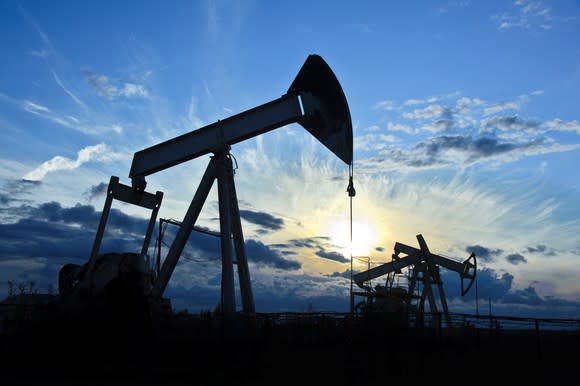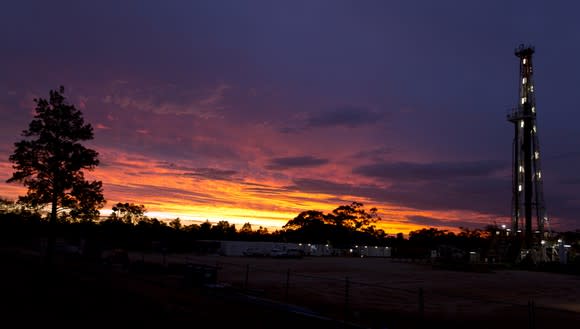3 Things to Watch When Devon Energy Corp Reports Fourth-Quarter Results
Like many rivals, Devon Energy (NYSE: DVN) ran into an unexpected headwind in the third quarter after Hurricane Harvey pounded the Gulf Coast, which forced the industry to shut-in wells and tap the brakes on their drilling activities. However, the company said its operations bounced back quickly, which kept it on pace to hit its full-year production target. Hitting that goal is one of three things investors should check out when the company reports its fourth-quarter results next Tuesday evening.
See if production met expectations
Devon Energy expected to end last year producing between 551,000 to 571,000 barrels of oil equivalent per day (BOE/D). Of that amount, it thought oil production in the U.S. would be between 120,000 to 125,000 barrels per day. That rate would put its U.S. crude output from retained assets up 20% since the beginning of the year.

Image source: Getty Images.
Hitting that target is important for the company because its U.S. oil production earns the highest margins, and therefore helps drive profitability. There's reason to be optimistic that the company can hit its production target because it drilled another gusher in the STACK Shale play during the quarter. Devon noted in mid-November that the Faith Marie 1-H well delivered a peak 24-hour rate of 5,100 BOE and was on pace to produce an average of 4,600 BOE/D during its first month in operation. Further, the company pointed out that this well had the highest oil productivity of any STACK well it had drilled. That well was just one of 25 in the region that the company expected to bring online during the quarter, which put it on pace to boost output from 111,000 BOE/D in the third quarter to more than 120,000 BOE/D by the end of 2017.
Look for an update on assets sales
The STACK has become one of Devon Energy's core areas of focus over the past year due to the high returns it can earn from drilling gushers like Faith Marie. Because Devon is shifting most of its attention to that play as well as the Delaware Basin, it has has been selling off other assets to strengthen its balance sheet. The company unloaded $3.2 billion of properties in 2016 and announced last May that it would jettison another $1 billion of assets over the next 12 to 18 months.
The company has already made excellent progress on that latest sale plan, sealing deals to sell $420 million of properties through the third quarter. However, it still had one large asset left to unload, which was a portion of its land in the Barnett Shale. Devon expected to receive bids for that asset during the quarter, which is why investors should see if it has an update on this sale. If Devon can find a buyer willing to meet its price, it would push the company closer to its debt reduction target while also improving companywide margins and profitability.

Image source: Getty Images.
Keep an eye on the guidance for 2018
In addition to looking back at 2017, Devon Energy will also likely provide a glimpse at what's to come in 2018 by unveiling its capital budget and production growth outlook. The company's preliminary view is that it will spend between $2 billion to $2.5 billion this year, and invest the bulk of that capital in the STACK and Delaware Basin, which should help boost output in those regions by 30%.
However, in addition to growing output, one other thing to watch is if Devon joins rival drillers in ramping up cash returns to investors this year. Devon, like so many peers, slashed its dividend and sold stock in early 2016 to shore up its financial situation as oil prices continued crashing. However, with oil prices and cash flow improving in the past year, many oil companies are beginning to return more cash to investors by increasing their dividends and buying back stock. For example, Anadarko Petroleum (NYSE: APC) boosted its dividend five-fold this year, which brought the payout up to $0.25 per share each quarter, which is just $0.02 per share off its peak in 2015. Meanwhile, after selling $2 billion in stock two years ago to pay for an acquisition, Anadarko plans to buy back $3 billion in shares by the end of this year after recently adding $500 million more to its initial authorization from last fall. Anadarko is just one of several oil producers to announce significant cash returns to investors this year, which puts pressure on Devon to announce a similar move.
The catalyst to watch closely
After drilling another gusher in the STACK during the quarter, Devon should have ended 2017 on a positive note. That would position it for continued strong growth in 2018. That said, the factor that could play the biggest role in driving the stock this year is whether Devon announces plans to return more cash to investors. That's because these decisions have fueled big gains for investors in rival oil stocks. In Anadarko's case, its shares have risen more than 22% since announcing a buyback program last fall, while Devon's hasn't budged. As such, Devon might put an end to its underperformance by following in the footprints of its peers.
More From The Motley Fool
Matthew DiLallo has no position in any of the stocks mentioned. The Motley Fool has no position in any of the stocks mentioned. The Motley Fool has a disclosure policy.

 Yahoo Finance
Yahoo Finance 